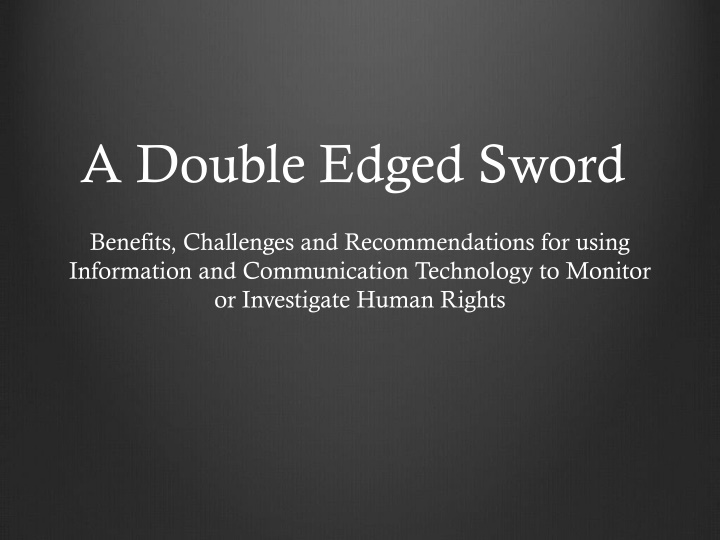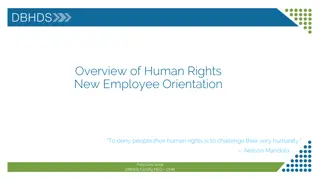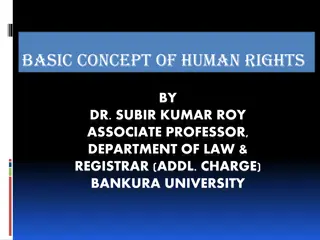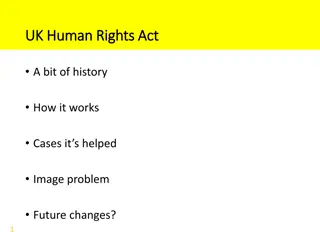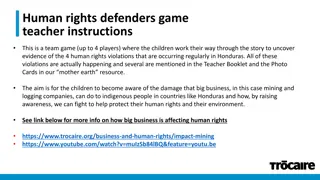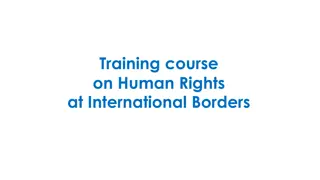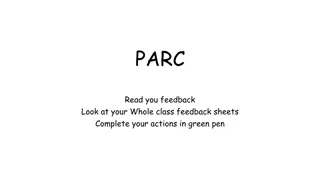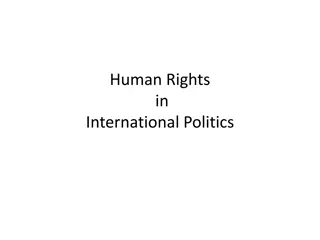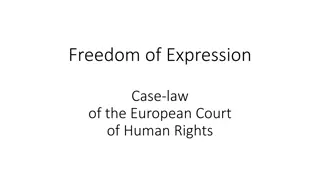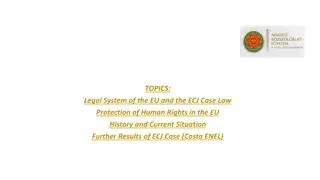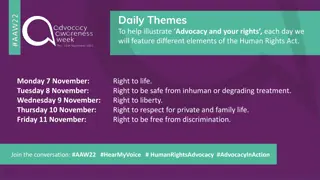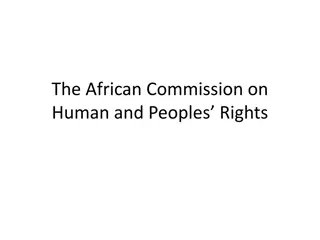Harnessing Information and Communication Technology for Human Rights Research
Researchers are exploring the use of ICT tools like satellite imagery and social media for human rights fact-finding, facing challenges in implementation but benefiting from remote data collection. The study aims to bridge the gap in academic literature on utilizing technology effectively in human rights research through practical guidance and real-world insights gathered from interviews and surveys.
Uploaded on Oct 04, 2024 | 5 Views
Download Presentation

Please find below an Image/Link to download the presentation.
The content on the website is provided AS IS for your information and personal use only. It may not be sold, licensed, or shared on other websites without obtaining consent from the author.If you encounter any issues during the download, it is possible that the publisher has removed the file from their server.
You are allowed to download the files provided on this website for personal or commercial use, subject to the condition that they are used lawfully. All files are the property of their respective owners.
The content on the website is provided AS IS for your information and personal use only. It may not be sold, licensed, or shared on other websites without obtaining consent from the author.
E N D
Presentation Transcript
A Double Edged Sword Benefits, Challenges and Recommendations for using Information and Communication Technology to Monitor or Investigate Human Rights
Introduction Research questions: How are researchers using ICT in their fact-finding work? What are the benefits? What are the challenges? How do you overcome those challenges? How is technology changing traditional research methodology? Why Now? Increasing use of technology for human rights documentation Lack of academic literature, as well as a lack of practical guidance for researchers (manuals and guidelines) Need to better understand technology in order to better utilize it Need to begin overcoming the challenges Objective: To fill a literature gap in academic work that examines the impact of ICT tools specifically on human rights fact-finding methods and, most importantly, create a manual that can be used by human rights researchers wanting to better harness ICT in their day to day work.
ICT Tools Examined Satellite imagery, social media and crowdsourcing platforms Each have unique sets of benefits, challenges and solutions to overcome those challenges BUT, they all share two common features that change traditional research methods: Allow researchers to collect information remotely Allow researchers to collect Big Data Devices vs. Tools: Devices require a physical presence in the field (smartphones, apps, hidden camera s, drones etc) Tools can be used to collect information captured on devices but do not require the researchers physical presence in the field
Research methods Literature Review Discovered a lack of academic literature focusing specifically on how new tools are actually being used in the field and the impact they are having on individual researchers Lack of practical guidance for researchers in how to best utilize technology Interviews 33 experts interviewed: practitioners, technology experts and academics Survey Attempt to quantify qualitative data and produce statistics that could represent larger trends 66 human rights researchers completed online survey 52 questions with different questions promoted based off previous responses Strict criteria for inclusion in the survey, only researchers working for IGO s, INGO s and NGO s collecting data for the purposes of advocacy, lobbying and human rights monitoring (did not include academics or think tank researchers) Research aim: to collect the most relevant, timely and practical data available, therefore the majority of my research was derived from practitioners feedback, guidance and real-world experiences
Divergent ideologies Traditionalists: believe that researchers must rely on traditional research methods in order for their research to have merit. They are not opposed to the use of ICT in human rights work, but feel that it s best used for information management, data organization, and data storage, rather than as a tool for data collection. Moderates: believe that ICT tools offer a number of advantages to human rights researchers, and strengthen the data collection process, but only when used in conjunction with traditional research methods. Futurists: believe that ICT tools are the future of human rights fact- finding, and researchers or HROs that don t currently utilize technology are missing out on massive opportunities. Futurists do not believe there is no merit in traditional fact-finding, they understand and acknowledge the work of traditional human rights researchers, however, they feel ICT tools provide more efficient data collection methods and could one day replace researchers.
Satellite Imagery: Context Became a research tool in early 2000 s when satellite companies began to privatize. Google earth and the 2006 Eyes on Darfur investigation by Amnesty International were also changing moments. Currently the biggest providers are DigitalGlobe and Airbus the market matters because it impacts researchers capabilities. Increasingly used as a tool in investigations- 39% of respondents have used satellite imagery in an investigation, and 35% of those respondents say they use it frequently. The majority of respondents started using satellite imagery in the last 5 years. Some major barriers still exist: of the 61% of respondents who do not use satellite imagery in their work, 50% said this was due to their lack of understanding in how to source and analyze images
Satellites Imagery: Benefits Access to non-permissive environments Allows researchers to revisit certain points in time Provides a level of detail not available in testimony or other evidence Images cannot be intimated and are difficult to dispute Allows researchers to track events over a large area Enhances ground research
Satellite Imagery: Challenges Lack of training for researchers (73% of users have never received training) Outsourcing the analysis, confidentiality and tension in the researcher analyst relationship Lack of peer review structures and processes inside HROs National Laws impeding where images can be captured Relying on private companies and therefor allowing competing client interests to jeopardize investigations Politics impacting which provider to work with Ethics around geo-location and revealing coordinates Costs making this an inaccessible technology for many local HRO s
Recommendations More internal training and more manuals needed, outlining the basics of satellite imagery and it s capabilities Improved communication and understanding between researchers and analysts Satellite images should always be use as part of a larger investigation, evidence collected through satellites cannot stand alone Be wary of private providers and make ethical decisions about which providers to rely on for certain investigations Increase internal competency, get a second opinion and improved peer review processes New codes of conduct around geo-location standards needed
Social Media: Context The Arab Spring was a monumental shift forward, demonstrating how social media could be utilized as a data collection tool. The Syria conflict now dubbed the youtube war , because Youtube has essentially become an evidence locker Social media is the most commonly utilized tool, 82% of respondents use it in their work, 35% use it daily and 30% use it weekly. 80% use Facebook, 70% use Twitter, 61% use Youtube and Whatsapp also revealed to be commonly utilized How is SM being used? 81.5 use it to follow up on incidents that they have heard about through other means and 64% also use it to discover new events they have not heard of elsewhere, 27% also indicated using as a way for sources to contact them directly. Primarily used to gather data on trends in specific regions and collect video evidence.
Social Media: Benefits Facilitates access to people and restricted places (87% of users indicated this as the primary benefit) Facilitates communication directly with sources Allows researchers to collect citizen generated media Allows research to track event sin real time Circumvents controlled information streams
Social Media: Challenges Verifying and authenticating social media derived data The digital divide, ensuring the voices of all victims are heard Information overload and mining through Big Data Disappearing citizen generated media and ensuring safe storage Security and surveillance when using online tools Obtaining informed consent from social media posters and the ethics around sourcing private vs. public information
Recommendations Verification tips for social media derived data and improving the capacity of researchers to verify data digitally Overcoming the digital divide relies on traditional research methods New technologies now available to help overcome the big data problem, but prioritizing issues still falls into the hands of a researcher Re-evaluating data storage practices and developing new systems Mandatory digital security audits for all HROs and researchers Obtaining informed consent
Crowdsourcing: Context The first deployment of Ushahidi during the 2007/2008 post- election violence in Kenya was a game changer Different crowdsourcing models serve different purposes, defining the model used in this research Examples: The Libya Crisis Map, Haiti Earthquake Crisis Map and the Syria Tracker vs. the LRA Crisis Tracker Least utilized tool by survey respondents, with only 24% of respondents referencing crowdsourcing platforms in their research work, with 69% of users doing so to find locations, and 63% also using them to examine trends on a specific topic or in a specific location.
Crowdsourcing: Benefits Many benefits similar to that of social media, because these tools aggregate data from social media platforms automatically and therefore provide access to CGM as well, and allow researchers to gain access to non-permissive environments Allow researchers to clearly visualize mass quantities of data with ease Provide access to data from online AND offline sources (volunteer submissions, call in and SMS submissions, trained staff networks) and expands the reach of researchers The ability to collect statistical data and conduct non probability sampling
Crowdsourcing: Challenges Authenticating and verifying crowdsourced data, specifically offline data (63% of users indicated this is the largest challenge) and obtaining informed consent. Trusting external data aggregators and their standards Skewed data sets from the digital divide and duplication Security risks for crowdsourcing participants Lack of relevant platforms (27% of non-users indicated they don t know of a relevant platform to use).
Crowdsourcing platforms: Recommendations Tips for verifying crowdsourced data, specifically offline sources, and obtaining informed consent Use platforms to identify trends and then investigate further through traditional methods More and better partnerships between technologists and human rights researchers
Conclusions Moderates theorists prevail: technology does pose many benefits to researchers, and is most effective when used in conjunction with traditional research methods. It does not have the capacity to surpass traditional research methods because human beings are an integral part of the verification process. In final survey question, 48% of respondents answered that ICT tools are a step forward but should only be used in conjunction with traditional research methods AND 44% indicated that ICT tools could be even more useful if there were more manuals and training opportunities specifically for researchers. Double meaning of double-edged and a final warning to the documentation community.
